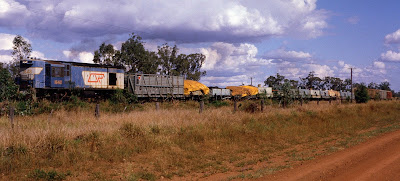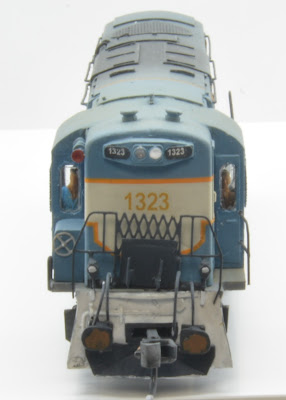There is still a few kits in the cupboard for a rainy day. These two have been there for quite some time.
Dad and Dave
I don’t have to much to share regarding the porotype, just general information. Both locomotives were English Electric and spent most of their time on the network in the northern part of the state. However, both classes would from time to time visit the Redbank Workshops and work trains in the Brisbane area before returning north.
ARHS publication “Locomotives in the Tropics” Volume 3 by John Armstrong gives a detail account of both classes of locomotives.
The
1300 class locos commenced entering service in late 1967, loco 1344 the last
one of the class entered service in 1972, all were withdrawn by the end of
1988. The class was sold to the Australian National Railways and were shipped
from Gladstone to Tasmania. They spent
most of their life as Central Division based locomotives used mainly in the coal
traffic, during quite times the locomotives would be found on Goods/Freight
services in the area.
Thankful, the kit contained two photos with the one-page instructions.
Luckily, I have a few more photos on the 1620’s. These locomotives also worked mainly in the north and did the loins share of work on Branch and Regional lines in Central and Northern Divisions until after electrisation of the Brisbane suburban area. By the early 1990’s, 1720 class locomotives had replace them and they were progressively withdrawn from service. Locomotive 1620 entered service in 1967 and the last locomotive in the class, 1653 in 1969, most were withdrawn in 1997. Three units were sold to the Mary Valley Rattler, eight to J. Holland Construction in the Philippines, loco 1650 to ARHS and 1620 is part of QR Heritage.
For
what it’s worth, I feel the 1620’s were one of the better looking locomotives
on the QR network.
1620 returning from Beaudesert with a short sheep train.
Same train running through Rocklea. Loco turned at
Bethania.
Aug 1986.
A few months later, 1620 shunting Rocklea, fresh out of workshop.
Changing crews Mayne, 1969.
Guard tuition and watering duties Beaudesert Branch. (Photo R. White)
568 shunt train Coopers Plains. Mid 1970’s
1645 was the class “lemon”, spending most of its early days confined to southside shunts (mainly train 568), not to be rostered on passenger trains. However, when things went pear shape, 1645 on the shunt would be called on to help out.
Biloela local goods, mid 1980’s.
Finch Hatten show special leaving Mackay.Blackall local Mixed waiting departure time.
Profile Train North Ipswich. Oct 1992.
Restored heritage 1620 assist an ARHS special on the Toowoomba Range.
Models. Both
locos are Far North Hobbies (FNH) kits with a K & M mechanism.
The 1300 loco kit was purchased from J & J Hobbies about 20 plus plus years ago. This kit was quite different to other kits.
The
mechanism was in the box, and very different to other K & M power houses.
The base plate was also the loco footplate, where was no motor. This set the
high of the loco that could not be altered.
I change my painting method, using painted decal paper for lining. The same paints were used as in the previous blog on the QLX Power Car (Dec 2023). A primer was applied first to the resign body, followed by the white. Once dry the required area was masked off and blue paint was sprayed. To finish the blue was masked off to paint grey section of the roof.
For
the lining a section of decal paper was spray with the orange paint.
Styrene strip was used as a guide to cut the lining to a
uniform width. Thanks Luke for the trip.
The
biggest issue is making the curves, the decal paper does not bend. Thus, some
are on the straight side. I understand a bow pen can be used to make good
curves.
The
hand rails are a brass etch I had in the box. Given the mechanise frame, the
coupler height was high. Even with an overset coupler (top of coupler on shaft),
more work is required for a correct setting.
The
1620 kit was purchased second hand. Some of the parts were not correct. The
steps and bogie side frame were for a 1720 class loco. Looking around a set of
bogie frames were found and used. Steps and a battery box was scratch built.
1634
The required shape was drawn up on graph paper, help to keep everything square. The brass wire was bent to shape and held together with double sided tape for soldering.
After finishing the loco, I found another set of etch brass
hand rails. It was still a good excise.
On the scales, the loco weight is 271 grams.
Open windows and adding a crew puts the icing on the cake and
finishes the model nicely.
Both locos were weathered, vents were painted black, then a
home-made weak black wash (Vallejo water acrylic) was applied. A couple of
shades of brown (Vallejo Model Air) were sprayed over the body. A sand/dust
colour was used on the bogie side frames. To finish the locos, black was
sprayed on the roof behind the exhaust ports.
The front and rear numbers were made using my inkjet printer. A couple fonts were tried. The number boards beside the headlight’s are also off the inkjet printer. In “Word” a white number in the black background was printer off. The number comes out clear. The number board on the loco was painted white. The decal was placed on the loco. Once the decal had set, the protruding white on the number board was hand painted black.
In the cupboard I had a Wuiske Model 1550 class DEL set aside for weathering for a mate, I think it had been there for a number of years. Given I was painting the others, it was time to return the loco to its owner.
Trust you found the information helpful in your modelling endeavours, until next time have fun and enjoy the hobby.
We trust that 2024 will
be kind to you and many of your dreams can be achieved. I think it will be a
big year for QR modellers.
Yesterday, my order of
SDS/CGL Models 1460/1502 locomotives arrived. WOW ###. Some adjustment to engine power is now required
on the layout.
What a month, storms after storms, on two occasions we have lost the internet. One of three on Boxing Day look out our Computer, phones, NBN and providers modem, out of action for three weeks. Lighting was dancing along the power lines in front of the house, never seen anything it before, some in the area it burnt out their fuse box. Three weeks later we are just back to some order yesterday.
What’s next???, Wait,
next issued there will be more, it’s a bumper.
Arthur H.






















































No comments:
Post a Comment